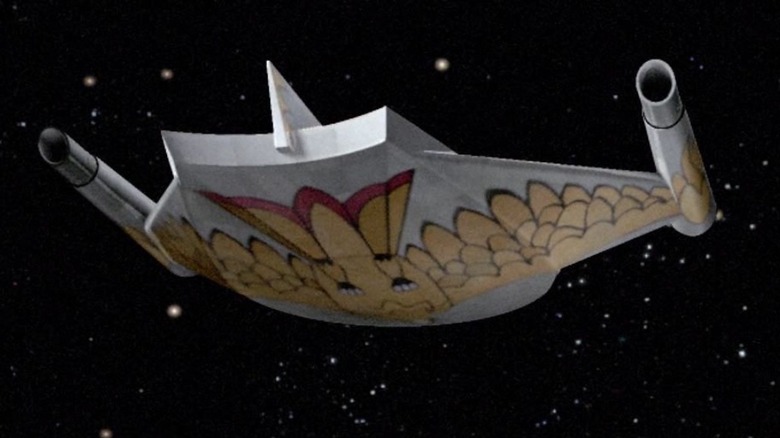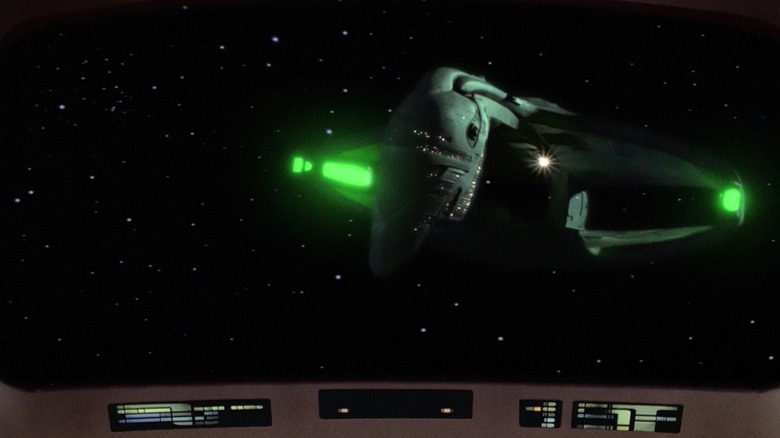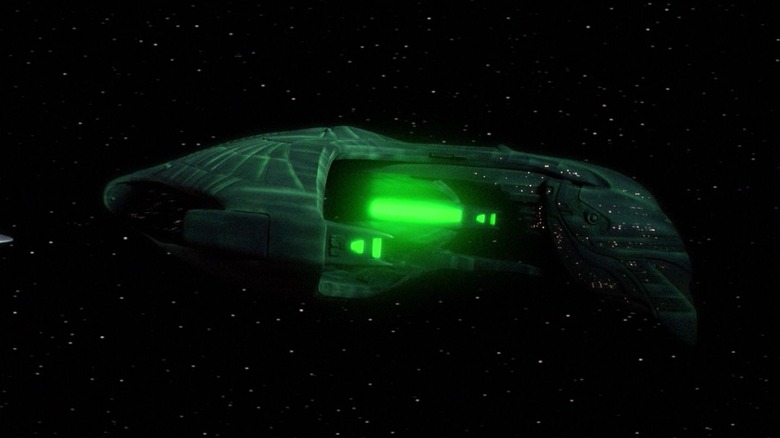Why Star Trek's Original Romulan Warbird Design Never Made It Into The Next Generation
The "Star Trek" episode "Balance of Terror" (December 15, 1966) features a face-off between the U.S.S. Enterprise and a mysterious Romulan Bird-of-Prey equipped with a cloaking device. The Romulan Bird-of-Prey is a flying saucer-like craft with warp engines protruding from either side and a wicked-looking tail fin on the back. It's colored light grey like the Enterprise but sports a painting of a large orange bird on its underside. Most ships on "Star Trek" are solid colors, emblazoned only with identification letters and maybe a racing stripe. Birds-of-Prey, with their bird paintings, looked like WWII bombers.
The painted Romulan Bird-of-Prey from the original series is a far cry from the Warbirds the Romulans would be seen piloting in "Star Trek: The Next Generation," set about a century later. On "Next Generation," Romulan Warbirds would be about 10 times larger, solid green, and constricted with outsize bird-like "heads." The wingspan of the Warbirds consisted of a large oval loop (a smaller craft could conceivably fly through it), and looking at the ship from above revealed a tapering shape.
The update came hand-in-glove with most of the visual updates made between "Star Trek" and "The Next Generation," two shows made 21 years apart. The Enterprise-D, for instance, is likewise larger than the original Enterprise, and it sports a swooping, elliptical design, rather than brutalist efficiency. There were, however, still similarities. Even in "Next Generation," starships featured an upper saucer section, a lower drive section, and a pair of warp engines that protruded from either side.
Why was the new Romulan Warbird so dramatically different? The 2012 book "Star Trek: The Next Generation 365" by Paula M. Block and Terry J. Erdmann might have the answer. It seems the new design was a wholly fresh idea by designer Andrew Probert.
The Neutral Zone
Probert recalled working on the episode "The Neutral Zone" (May 16, 1988), a notable episode, as it was going to be the first time the Romulans had been seen since the days of the original series. Before getting to work on designing the Romulan ship, Probert examined the Enterprise-D and noted that it was a flat, wide ship with a sharpened, chakram-like edge. Indeed, the Enterprise-D is almost as wide as it is long. Probert figured that the Romulan ship should be the opposite of the Enterprise-D, and designed a ship that was more vertically oriented. He said:
"I didn't have any information except that the Romulans were coming back and that we had never seen their ship before. [...] Since the Enterprise is so horizontal, I wanted to contrast it with a vertical ship."
His initial designs were indeed vertical. Too vertical it seems. They featured a sideways burger-shaped command center out front, and then a large, elliptical Uranus-like ring reaching up and down behind it. One can find pictures of Probert's initial designs online. Evidently, some of the show's producers thought the up-and-down look was too odd for "Star Trek," and demanded a more horizontal design. It was then that Probert first came up with the more bird-like shape the ship would ultimately have. This new draft, however, featured no "bottom wing," being a little more open. It was essentially a bird in flight.
Eventually, through several re-designs, the bottom wing would appear, and a preliminary version of how a Warbird looked would manifest.
Roddenberry wasn't around
Probert admitted that he began making his Romulan designs without much input from show creator Gene Roddenberry. If Roddenberry had been more active in production, no doubt the show creator would have had something to say about the way the Federation's oldest enemies might look. As it stands, the designers were left a little adrift, leaving them free to make up what they wanted. Probert recalled the lack of oversight, but also his confidence in how well his initial designs would have been received:
"At this point [in the series] we didn't see Gene Roddenberry anymore. [...] Gene had always been open to suggestions. I was in awe of how he had created the show, and my respect for him was enhanced by the fact that he would sit and listen to your ideas. He may not have always used them, but he would always listen. I felt that if I had shown him the vertical warbird and explained my reasoning, he would have considered it."
Hence why there was no "The Original Series"-era Bird-of-Prey on "Next Generation." A single rogue designer merely wanted to do something different.
Probert was a little miffed, however, that the final, on-screen version of the Warbird was a lot smaller than his imagination. He imagined the ship to be 4,440 meters long, whereas the Enterprise was only 641 meters long. Sadly, the VFX team on "Next Generation" never put their models close enough together to give audiences an idea of how big they were in comparison to one another. The Warbirds were still bigger, it seemed, but not enormously so.
Regardless, it's a pretty cool-looking ship.


